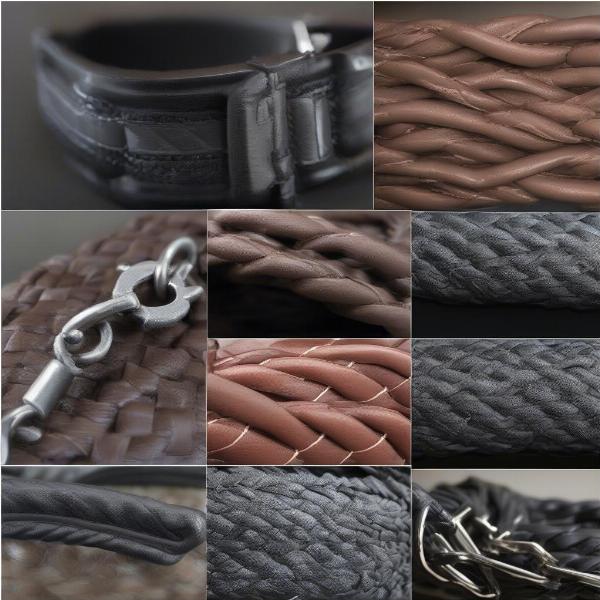Owning a large, powerful dog is a rewarding experience, but it also comes with the responsibility of ensuring their safety and the safety of others. A crucial part of this is choosing the right strong dog leads for large dogs. This guide will explore the various aspects of selecting, using, and maintaining a lead that is suitable for your powerful companion, ensuring both enjoyable walks and peace of mind.
Choosing the Right Lead for Your Large Dog
When selecting a strong dog lead for a large dog, several factors come into play, including material, length, and style. The right choice depends on your dog’s individual needs and your walking environment.
Lead Materials: Durability and Comfort
- Nylon: A popular choice due to its affordability, durability, and easy cleaning. However, it can be prone to fraying if your dog is a strong chewer.
- Leather: A classic and stylish option known for its strength and comfortable grip. Leather leads soften and mold over time, becoming even more comfortable with use. However, they require more care and maintenance than nylon.
- Biothane: A synthetic material that combines the strength and waterproof nature of nylon with the soft feel of leather. It’s a great option for dogs who love water or muddy adventures.
- Chain: While exceptionally strong, chain leads can be heavy and uncomfortable for both you and your dog. They are generally not recommended for regular walks.
 Different Strong Dog Lead Materials
Different Strong Dog Lead Materials
Lead Length: Balancing Control and Freedom
- Standard Length (4-6ft): Provides good control for everyday walks and training.
- Long Line (10-30ft): Allows for more freedom in open spaces while still maintaining a connection. Ideal for recall training or allowing your dog to explore safely in a controlled environment.
- Retractable Leashes: While convenient, retractable leashes are not recommended for large, strong dogs. They can easily break under pressure and the thin cord can cause burns to both the dog and the handler.
Lead Styles: Addressing Specific Needs
- Standard Lead: A simple and versatile option suitable for most dogs.
- Slip Lead: Tightens around the dog’s neck when pulled, providing more control. However, they can be uncomfortable or even harmful if used incorrectly.
- Harness Lead: Attaches to a harness rather than a collar, distributing pressure more evenly and reducing strain on the neck. Highly recommended for large, strong breeds.
Maintaining Your Dog’s Lead
Regular inspection and care will ensure the longevity of your dog’s lead. Check for signs of wear and tear, such as fraying, cracks, or broken hardware. Clean your lead regularly, especially if it gets wet or muddy. Leather leads require occasional conditioning to maintain their suppleness and prevent cracking.
Training Your Dog to Walk Nicely on a Lead
Even with the strongest lead, a well-trained dog is essential for enjoyable walks. Positive reinforcement methods, such as rewarding good behavior with treats and praise, are effective for teaching your dog to walk calmly on a lead. Consistency and patience are key to success.
Conclusion
Investing in a strong, durable, and appropriate lead is a vital part of responsible dog ownership, especially for large breeds. By considering your dog’s individual needs and understanding the different types of leads available, you can ensure both their safety and your peace of mind during walks and other activities. Remember that proper training and lead handling techniques are equally important for a harmonious walking experience.
FAQ
- What is the best material for a strong dog lead? Biothane and leather are excellent choices for strong, durable leads.
- Are retractable leashes safe for large dogs? No, retractable leashes are not recommended for large, strong dogs as they can break and cause injury.
- How long should a lead be for a large dog? A standard 4-6ft lead is suitable for most walks, while a long line offers more freedom in open spaces.
- How can I train my large dog to walk nicely on a lead? Positive reinforcement methods, like rewarding good behavior, are effective for lead training.
- How do I care for my dog’s lead? Regularly inspect for wear and tear and clean the lead according to its material.
anxious dog lead
st ives dog friendly accommodation
dog filter png
dog friendly chocolate
ILM Dog is your trusted source for expert advice on all aspects of dog care, from breed selection and health to training and nutrition. We offer practical tips and insights to help you provide the best possible care for your furry friend. For personalized guidance or to learn more about our services in breed selection, health & medical care, training & behavior, and products & accessories, contact us at [email protected] or +44 20-3965-8624. Visit ILM Dog for more information.